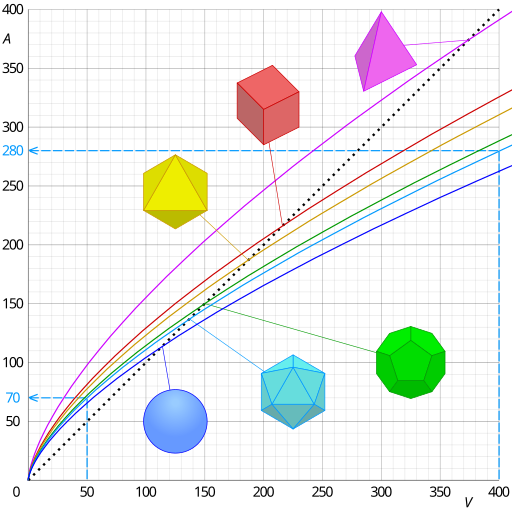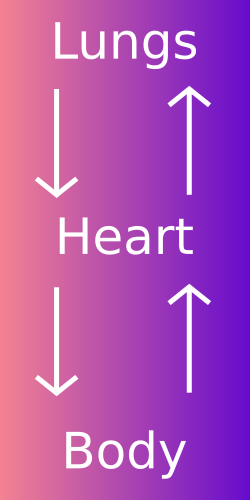OCR Specification focus:
‘Larger, more metabolically active animals with low surface area to volume ratios require transport systems to supply nutrients and remove wastes efficiently.’
As animals grow in size and complexity, their surface area to volume ratio (SA:V) decreases and metabolic demands increase, making efficient internal transport systems essential to deliver oxygen and nutrients and remove waste products.
The Need for Transport Systems in Multicellular Animals
Surface Area to Volume Ratio and Diffusion Limitations
Small, single-celled organisms rely on diffusion alone for the movement of substances, as their large SA:V allows rapid exchange across the cell surface. However, as organisms become larger, the SA:V falls sharply, reducing the efficiency of diffusion.

Graphs show how surface area and volume scale for common shapes, illustrating that SA:V decreases as size increases. A lower SA:V means proportionally less surface for exchange relative to metabolic demand. This underpins the need for internal mass transport in large animals. Source.
In a small organism, every cell is close to the external environment.
In large animals, many cells are deep within tissues and cannot directly access oxygen or nutrients.
Diffusion alone becomes too slow to meet the metabolic rate required for active processes such as movement, thermoregulation, and growth.
Example: A flatworm, with its flattened body shape, maintains a high SA:V and relies on diffusion. By contrast, a mammal with a low SA:V must have a specialised transport system such as a circulatory system.
Increasing Metabolic Demands
Larger and more active animals have greater metabolic rates, meaning they use energy rapidly. This energy is primarily generated through aerobic respiration, which requires a continuous supply of oxygen (O₂) and the removal of carbon dioxide (CO₂).
High metabolic rate → greater oxygen and nutrient demand.
Rapid waste production → increased need for removal systems.
Internal tissues → require constant supply of glucose, amino acids, ions, and hormones.
Metabolism: The sum of all biochemical reactions occurring within an organism, including both energy-releasing (catabolic) and energy-consuming (anabolic) processes.
Because of these energetic requirements, diffusion is insufficient; instead, mass transport systems are required to move materials efficiently over long distances.
Features and Functions of Transport Systems
Components of a Typical Transport System
Although structures vary among taxa, efficient transport systems share key features:
A transport medium — a fluid such as blood or haemolymph to carry substances.
A pump — usually a heart, to generate pressure and move the medium.
Vessels or pathways — such as arteries, veins, and capillaries to direct flow.
Exchange surfaces — e.g. capillary beds, where substances enter or leave the medium.
Mass transport: The bulk movement of substances over large distances due to pressure gradients within a fluid.
Together, these components form an integrated network that maintains homeostasis by ensuring the delivery of essential materials and removal of metabolic wastes.
Transport Systems in Relation to Body Size and Activity
Small Organisms
Simple diffusion suffices.
Minimal metabolic demand.
Short diffusion distances.
Larger Inactive Organisms
May rely on slow circulation or body cavity fluid movement.
Example: Sea anemones use water flow within the gastrovascular cavity for internal transport.
Large Active Organisms
Require specialised circulatory systems.
Example: Mammals possess a double circulatory system ensuring high pressure in systemic circulation to meet energetic demands.

A labelled overview of double circulation in mammals, with blood passing through the heart twice per circuit—once to the lungs, once to the body. Separation of oxygenated and deoxygenated blood maintains pressure and gradients, enabling efficient transport over long distances. This visual directly supports why large animals require robust internal circulation. Source.
Environmental and Structural Influences
Surface Area to Volume Ratio (SA:V)
The SA:V ratio determines how effectively an organism exchanges materials with its environment. As volume increases faster than surface area during growth, each cell’s access to oxygen decreases unless internal transport compensates.
EQUATION
—-----------------------------------------------------------------
Surface Area to Volume Ratio = Surface Area ÷ Volume
SA = Total area of an organism’s outer surface (m²)
V = Total internal volume (m³)
—-----------------------------------------------------------------
Low SA:V ratios drive the need for efficient internal distribution networks and exchange organs, such as lungs or gills, to maintain adequate supply to all tissues.
Activity Level and Oxygen Demand
Active animals (e.g. mammals, birds) have higher energy requirements for sustained movement and thermoregulation. Their circulatory systems are correspondingly more complex, ensuring rapid delivery of oxygenated blood.
In contrast, ectothermic or less active species (e.g. amphibians, reptiles) have lower oxygen demands and less efficient or partially open circulatory systems.
Examples Across Taxa
Insects
Possess an open circulatory system, where haemolymph bathes organs directly.
Oxygen transport is largely independent of circulation, achieved through a tracheal system.
Lower pressure and slower distribution, suitable for small body size and moderate activity.
Fish
Exhibit a single circulatory system, where blood passes once through the heart per circuit.
Oxygen uptake occurs via gills, and blood pressure drops after gas exchange.
Efficient for aquatic life but limits high metabolic rates.
Mammals
Possess a double closed circulatory system:
Pulmonary circulation: carries deoxygenated blood to the lungs.
Systemic circulation: delivers oxygenated blood to body tissues.
Maintains high pressure and separation of oxygenated and deoxygenated blood.
Supports large body size and sustained activity.
Closed circulatory system: A system where blood is contained within vessels and flows in a continuous circuit powered by a muscular heart.
This arrangement ensures rapid, directed flow and efficient transport, supporting mammals’ endothermic metabolism.
Transport and Homeostasis
Transport systems are integral to maintaining homeostasis — the stable internal environment required for optimal cellular function. These systems distribute nutrients, hormones, and heat, while removing urea, CO₂, and other wastes.
Key roles include:
Delivering oxygen and nutrients for cellular respiration.
Removing metabolic wastes to prevent toxic accumulation.
Distributing hormones and immune cells.
Maintaining body temperature through blood flow regulation.
Homeostasis: The maintenance of a stable internal environment despite external changes.
By integrating respiratory, digestive, and excretory systems, transport mechanisms allow multicellular animals to thrive in diverse environments, meeting the OCR requirement that larger, more metabolically active animals require transport systems to supply nutrients and remove wastes efficiently.
FAQ
Body shape affects how easily substances can diffuse across an organism’s surface. Flattened or elongated shapes increase surface area relative to volume, improving diffusion efficiency.
For example:
Flatworms have a thin, flat body that keeps all cells close to the surface, so diffusion is sufficient.
Spherical or thick-bodied animals have a low surface area to volume ratio, limiting diffusion efficiency.
As body thickness increases, internal cells become further from the surface, creating the need for specialised transport systems to deliver nutrients and oxygen throughout the body.
Endotherms maintain a constant internal temperature using metabolic heat, demanding high energy and oxygen intake. This requires:
A double circulatory system to maintain high pressure and separate oxygenated and deoxygenated blood.
High cardiac output to deliver oxygen quickly to tissues.
Ectotherms rely on external heat sources, so their metabolism is lower, and simple or less efficient transport systems can meet their needs.
Diffusion time increases exponentially with distance. A small rise in the distance between the surface and inner cells dramatically slows diffusion.
For example:
A molecule may cross a cell in milliseconds,
But it would take hours to diffuse across a large tissue without circulation.
As organisms grow, increased diffusion distance makes passive exchange insufficient. Therefore, active transport systems evolved to maintain fast, large-scale movement of materials.
Animals use structural and physiological adaptations to enhance transport efficiency:
Highly branched capillary networks increase surface area for exchange.
Circulatory pumps such as hearts maintain pressure.
Respiratory pigments (e.g. haemoglobin) increase oxygen-carrying capacity.
Efficient ventilation mechanisms (e.g. lungs or gills) maintain diffusion gradients.
These features enable even large animals to move substances rapidly without altering their overall body proportions.
The effectiveness of diffusion depends on both metabolic demand and environmental conditions.
Low-activity multicellular organisms, such as cnidarians, live in water and have thin tissues, so oxygen diffuses easily through moist surfaces.
By contrast, active land animals have high oxygen demands and thicker body structures that prevent sufficient diffusion. Hence, they require internal transport systems with blood or haemolymph to maintain supply and waste removal.
Practice Questions
Question 1 (2 marks)
Explain why large multicellular animals require specialised transport systems, whereas small unicellular organisms do not.
Mark Scheme:
1 mark for recognising that large organisms have a low surface area to volume ratio (SA:V), meaning diffusion alone is insufficient to meet metabolic needs.
1 mark for stating that specialised transport systems (e.g. circulatory systems) are required to move substances efficiently to and from cells deep within the body.
Question 2 (5 marks)
Discuss how the surface area to volume ratio and metabolic activity of an organism influence the need for a transport system.
Mark Scheme:
Award up to 5 marks for the following points:
1 mark: As an organism increases in size, its surface area to volume ratio decreases, reducing the efficiency of diffusion.
1 mark: A low SA:V means cells are further from the external environment, so diffusion distances become too great.
1 mark: Metabolic activity increases in larger or more active animals, requiring more oxygen and nutrients and producing more waste.
1 mark: Diffusion alone cannot meet these higher metabolic demands, so a specialised transport system is necessary.
1 mark: The transport system ensures the delivery of oxygen and nutrients and the removal of waste products, maintaining efficiency and homeostasis in large, active organisms.

